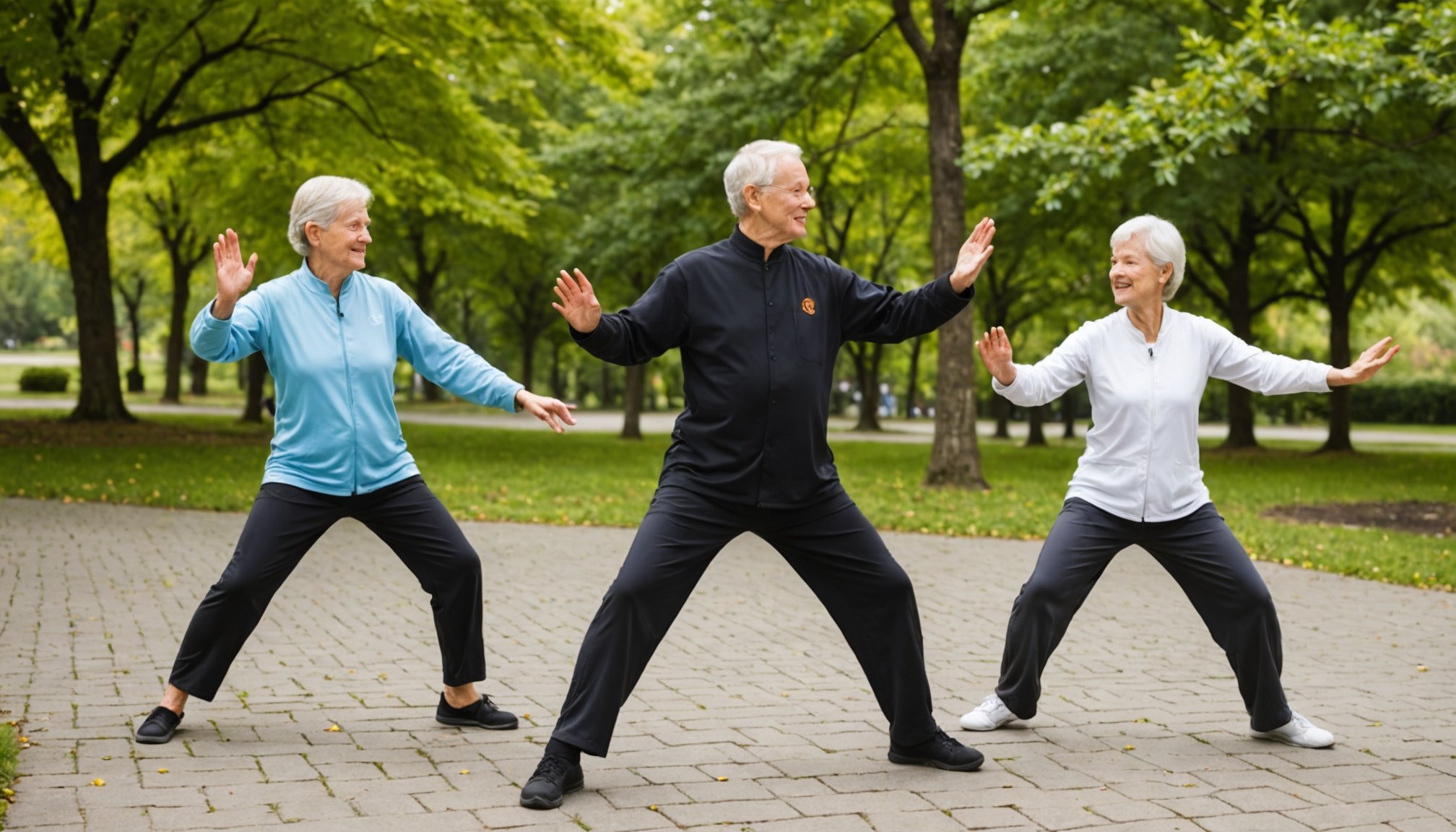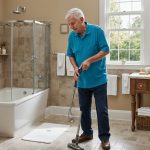Unlocking Balance and Flexibility: The Impact of Regular Tai Chi Practice for Seniors to Tai Chi
Tai Chi, an ancient Chinese martial art, has evolved over the centuries into a holistic mind-body practice that offers a myriad of health benefits, particularly for seniors. This gentle, low-impact exercise combines slow, flowing movements with deep breathing and meditation, making it an ideal activity for older adults looking to improve their balance, flexibility, and overall health.
The Physical Benefits of Tai Chi for Seniors
Improving Balance and Reducing Fall Risk
One of the most significant benefits of Tai Chi for seniors is its impact on balance and fall risk reduction. A comprehensive meta-analysis revealed that Tai Chi significantly improves balance and physical function in older adults, as measured by the Berg Balance Scale (BBS), one-leg standing with eyes closed (OLS-C), and the Timed up-and-go test (TUG)[1].
Also to read : Unlocking Speech Clarity: How Targeted Vocal Exercises Can Benefit Dysarthria Patients
- Berg Balance Scale (BBS): Tai Chi participants showed significant improvements in BBS scores, indicating better balance.
- One-Leg Standing with Eyes Closed (OLS-C): Tai Chi practice extended the duration of OLS-C, highlighting enhanced static balance.
- Timed Up-and-Go Test (TUG): Tai Chi was associated with faster TUG times, reflecting improved dynamic balance.
These improvements are crucial because falls are a major health concern for older adults, often leading to serious injuries and decreased quality of life.
Enhancing Flexibility and Strength
Tai Chi is not just about balance; it also enhances flexibility and strength. The slow, deliberate movements of Tai Chi help stretch muscles and create space and fluidity in the joints, easing stiffness and pain. This is particularly beneficial for seniors with conditions like osteoarthritis, where joint mobility is often compromised[3].
Additional reading : Exploring the Impact of Pet Dog Ownership on Reducing Anxiety Disorders in Children
- Knee and Hip Osteoarthritis: Studies have shown that Tai Chi can alleviate joint discomfort, reduce pain and stiffness, and improve walking and standing abilities in individuals with knee and hip osteoarthritis.
- Fibromyalgia: Tai Chi has been found to be more effective than conventional treatments in managing fibromyalgia symptoms, including pain, fatigue, and depression.
Mental Health Benefits of Tai Chi
Reducing Cognitive Decline
In addition to physical benefits, Tai Chi also has a profound impact on mental health and cognitive function. A recent study demonstrated that a cognitively enhanced Tai Ji Quan program significantly improved global cognition and reduced dual-task walking costs in older adults with mild cognitive impairment (MCI)[2].
- Montreal Cognitive Assessment (MoCA): Participants in the cognitively enhanced Tai Ji Quan group showed a 1.5-point improvement in MoCA scores compared to those practicing standard Tai Ji Quan and a 2.8-point improvement over those doing stretching exercises.
- Dual-Task Walking: The cognitively enhanced group also showed a 9.9% improvement in dual-task walking performance compared to the standard Tai Ji Quan group and a 22% improvement over the stretching group.
These cognitive benefits were sustained for up to 48 weeks, highlighting the long-term potential of Tai Chi in reducing dementia risk.
Managing Stress and Anxiety
Tai Chi incorporates deep breathing and mindful focus, which helps calm the nervous system and reduce stress. This mind-body practice is particularly beneficial for seniors who may feel too restless for seated meditation.
- Symptoms of Depression and Anxiety: A meta-analysis found that Tai Chi reduced symptoms of depression and anxiety, improving overall quality of life[5].
- Community Engagement: Practicing Tai Chi in a group setting fosters mental well-being by reducing loneliness and enhancing a sense of belonging, further contributing to a lowered risk of falls and improved mental health[1].
Practical Insights and Actionable Advice
Getting Started with Tai Chi
If you’re new to Tai Chi, here are some practical steps to get you started:
- Find a Local Class: Look for Tai Chi classes at community centers, gyms, or online platforms like SilverSneakers LIVE. Many programs offer classes specifically designed for seniors.
- Start Slow: Begin with short sessions, such as 15-minute classes, and gradually increase the duration as you become more comfortable with the movements.
- Focus on Form: Pay attention to the proper form and technique. Tai Chi is about slow, controlled movements, so it’s important to focus on the quality of the movements rather than the speed.
Home Care and Self-Practice
For those who prefer practicing at home, here are some tips:
- Use Video Resources: Utilize video tutorials and online classes to guide you through the exercises.
- Create a Safe Space: Ensure your practice area is clear of obstacles and has enough space to move around comfortably.
- Practice Regularly: Aim to practice Tai Chi at least 2-3 times a week, ideally for 30-60 minutes per session.
Comparative Benefits of Tai Chi
Here is a comparative table highlighting the benefits of Tai Chi against other common exercises for seniors:
| Exercise | Balance Improvement | Flexibility Enhancement | Cognitive Benefits | Pain Relief | Mental Health Benefits |
|---|---|---|---|---|---|
| Tai Chi | Significant improvement in BBS, OLS-C, and TUG[1] | Enhances joint flexibility and reduces stiffness[3] | Improves global cognition and dual-task walking[2] | Relieves chronic pain, including fibromyalgia and osteoarthritis[3] | Reduces symptoms of depression and anxiety[5] |
| Stretching | Limited impact on balance | Improves flexibility but less effective than Tai Chi[2] | No significant cognitive benefits | Some pain relief but less effective than Tai Chi[2] | Minimal mental health benefits |
| Yoga | Improves balance but less comprehensive than Tai Chi | Enhances flexibility | Some cognitive benefits but less focused than Tai Chi | Relieves pain but may not be as gentle as Tai Chi | Reduces stress and anxiety |
Real-Life Examples and Anecdotes
Many seniors have found Tai Chi to be a transformative practice that improves their quality of life. Here’s an example:
“Andrea, a 75-year-old retiree, was struggling with balance issues and chronic lower back pain. After starting a Tai Chi class at her local community center, she noticed significant improvements in her balance and a reduction in her back pain. She also felt more connected to her community and less lonely. ‘Tai Chi has given me a new lease on life,’ she says. ‘I feel stronger, more balanced, and more at peace.’”
Tai Chi is more than just an exercise; it’s a holistic practice that enhances physical health, cognitive function, and mental well-being. For seniors, regular Tai Chi practice can be a game-changer, offering a safe and effective way to improve balance, flexibility, and overall health. Whether practiced in a group setting or at home, Tai Chi is an accessible and beneficial activity that can help seniors live healthier, more fulfilling lives.
As Jenelle Kim, a doctor of Chinese Medicine, notes, “Tai Chi is an excellent way to manage stress, improve focus, and increase body awareness, which is useful in everything from sports performance to daily life.”[5]
So, if you’re looking to discover a new way to enhance your health and well-being, consider giving Tai Chi a try. With its gentle movements, deep breathing, and meditative focus, Tai Chi is an ideal practice for seniors aiming to improve their balance, flexibility, and quality of life.











